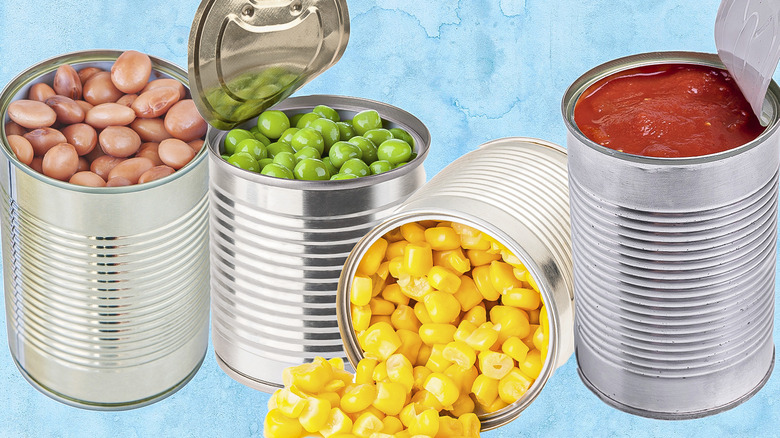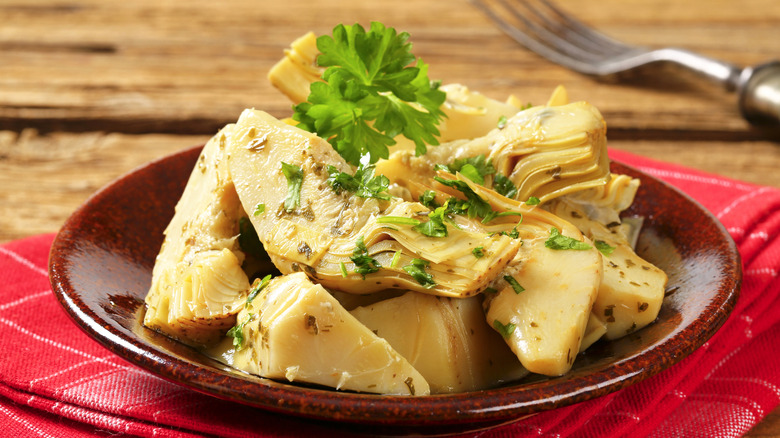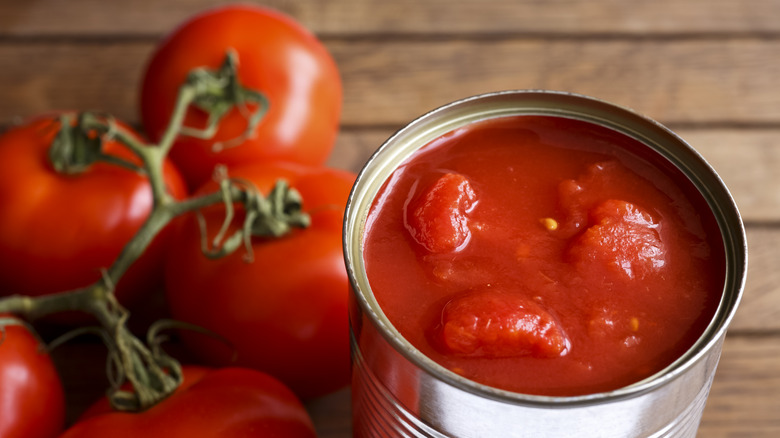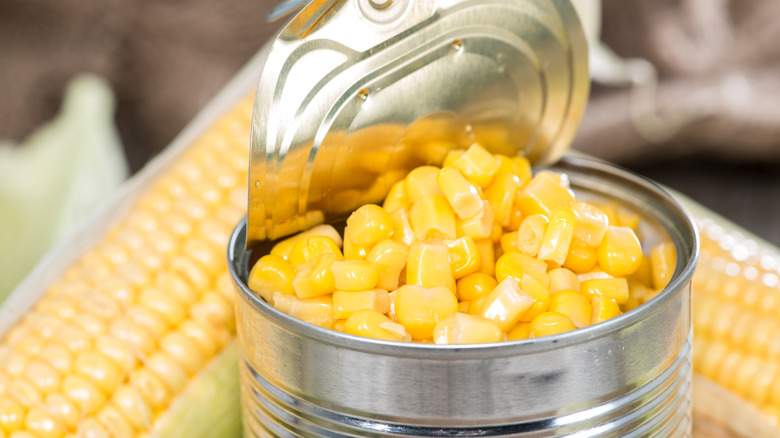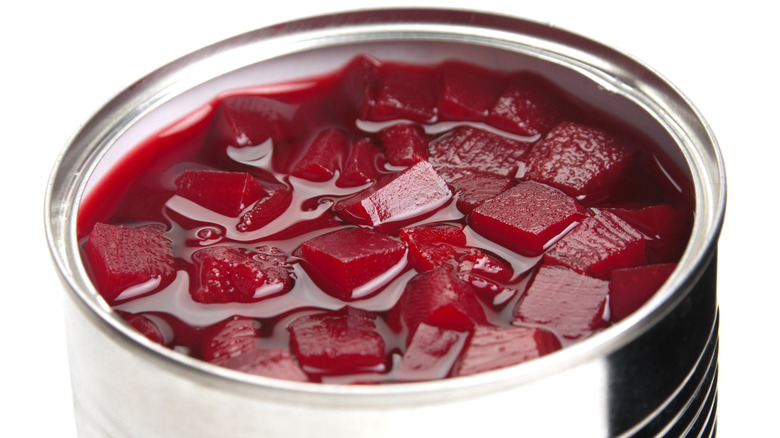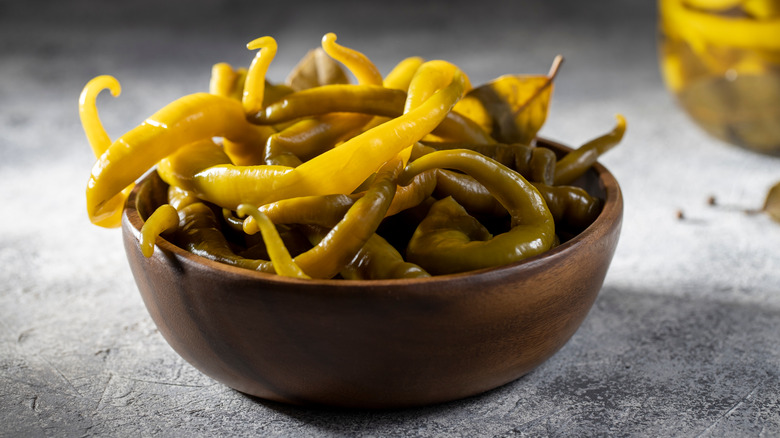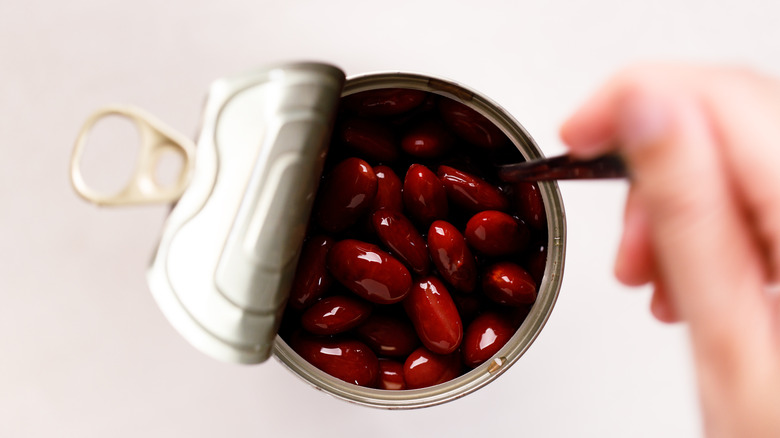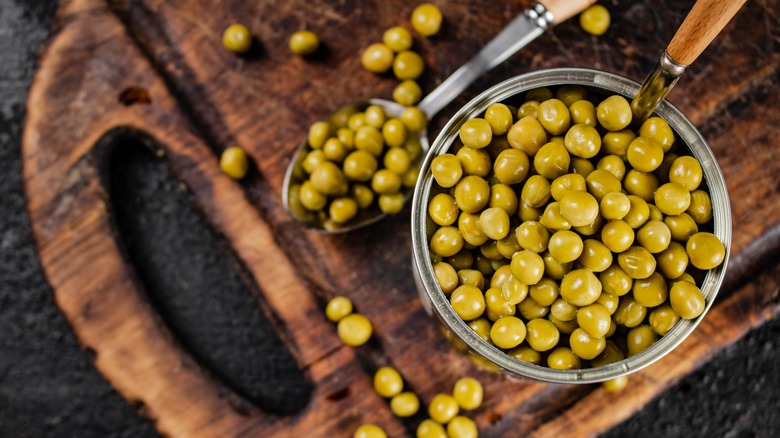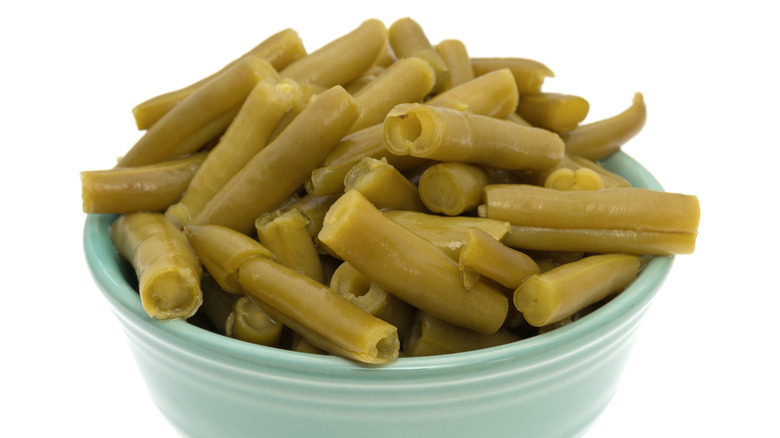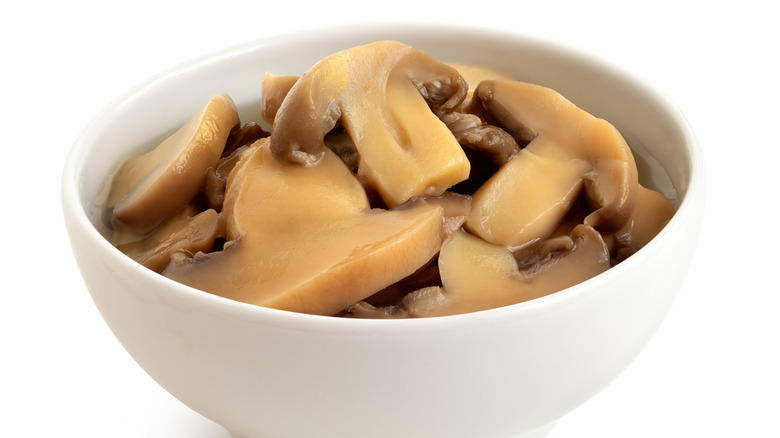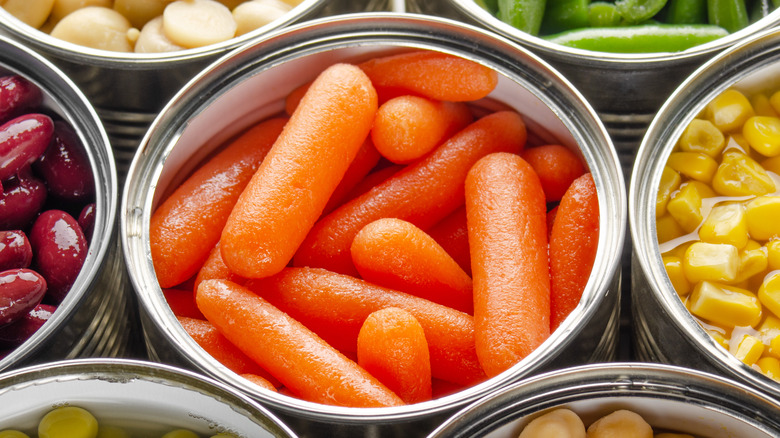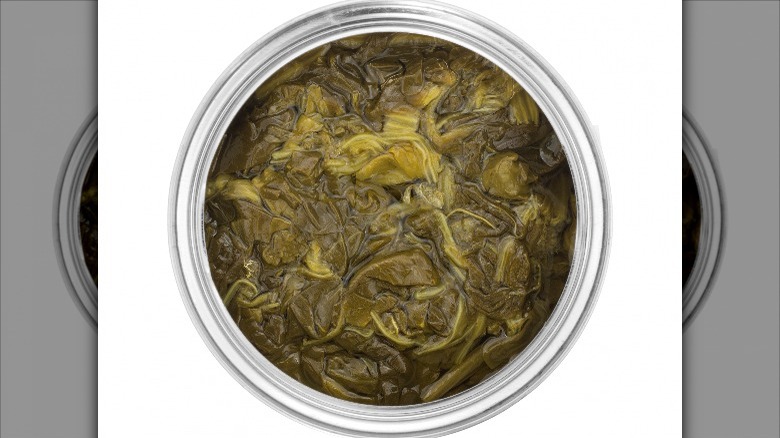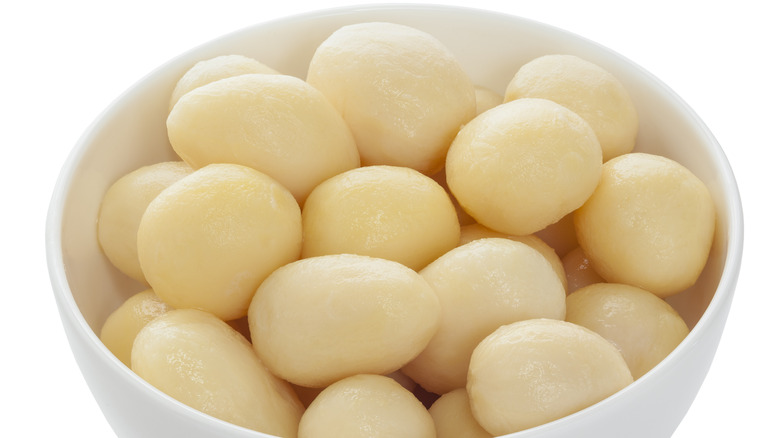6 Vegetables You Should Buy Canned And 6 You Shouldn't
Canning is by no means a novel preservation technique. Although some people frown upon the inferior quality of certain canned products, the technique has had a significant role in food history, especially during turbulent and less affluent times. The main reason we reach for canned goods nowadays is convenience. The ingredients packed inside usually come already cooked so they can be enjoyed immediately. Most cans have a long shelf life too, making them a welcome addition to any pantry.
Also, canned fruit and vegetables are sometimes significantly cheaper than their fresh counterparts. These nutritionally dense foods are essential to a healthy diet, but somehow, we always seem to lack enough of them. One way to improve this is to reach for the canned stuff. Although fresh is best, using canned vegetables is a quick way to increase our daily veggie intake. Of course, not all canned vegetables are made equal. Some rate better than others, mainly because they manage to retain most of their nutrients through the canning process without turning into soft mush.
Our recommendations will guide you through the best choices and warn you of the cans that are better left on the shelf. As the quality of canned goods can significantly vary, be sure to read labels to be familiar with what you are buying.
1. Should: Artichokes
An artichoke is a beautiful vegetable that is versatile in home kitchens, but most of us avoid it because of the difficult cleaning process and time-consuming preparation. Artichokes are edible heads that grow on top of a long, firm stem. The whole flower head is covered in thick, sharp leaves that need to be trimmed or completely removed to get to the artichoke heart — the part of the vegetable intended for cooking. The whole process takes time and requires some knife skills, which is why canned artichoke hearts come out as an obvious winner for home cooks.
Unlike the fresh version, canned artichokes have already been cleaned and prepped for you and are immediately ready to use in recipes. They have also been cooked, so there is no need to process them further if you want to add them to salads or blend them into a dip. As it is such a firm vegetable, it will retain its structure and have some bite, so you don't have to worry that it will instantly turn soft.
Ideally, you want to use canned artichoke hearts in any dish in which they are blended with other ingredients. Flavorwise, you will not see a difference in dips, spreads, casseroles, or sauces that use canned artichokes. However, if you are making a recipe that calls for braising or frying, you are better off with the fresh version.
2. Should: Tomatoes
Tomatoes are summer vegetables, but these days fresh varieties are readily available at larger supermarkets year-round. Despite the accessibility of fresh ones, the canned version can be an equally good (and sometimes superior) option for home cooks and professionals. Canned tomatoes can be diced, preserved whole (with no skin), or blended into a thick tomato purée. Each version has a particular use and is designed for a different purpose.
The greatest advantage of the canned version is that tomatoes are preserved at their peak, meaning all the sweet flavors of a perfectly ripe tomato are stored in the can. This is particularly useful if you are looking for tomatoes outside of their peak season. In these cases, fresh ones are usually shipped or grown in greenhouses, potentially lacking the exceptional ripeness and sweetness that make them such a tasty ingredient.
Also, it's worth mentioning that canned tomatoes have an envious nutritive profile. As The Guardian explains, the benefits of tomatoes typically improve with heat. Cooked tomatoes tend to have more lycopene (a pigment praised for its health benefits and preventive qualities) compared with the fresh version. Of course, let's not forget the sheer convenience of using canned tomatoes for any dish that calls for tomato sauce. With an excellent nutritional profile and reliable flavor, this is a vegetable you should buy canned.
3. Should: Corn
Corn is another American favorite you will often see served as a side dish, added to salads, or incorporated into soups or casseroles. In the absence of fresh corn, the canned version is a convenient and reliable option that provides crunch, flavor, and a relatively good nutritional profile.
Corn kernels packed in a can are pre-cooked and require no additional processing, so you can immediately mix them into any dish. Unlike similar small-sized vegetables such as peas, corn kernels have a pretty firm shell and retain their delicious crunchy texture despite being cooked in advance and preserved in brine. Compared to fresh or frozen corn, canned corn generally has more sodium, so keep that in mind if you want to include it in a recipe.
It appears that many readers agree that canned corn is a solid choice; in a recently conducted Mashed survey, canned corn was an absolute favorite, accounting for 44% of votes and beating artichoke hearts, asparagus, green beans, and lima beans.
4. Should: Beets
Fresh beets are sturdy and need plenty of time to cook. They are a hassle to clean, and the intense color somehow always manages to find a way to stain your counter, cabinets, and hands. But beets are also a great source of vitamins and minerals and a nutrient-rich, low-calorie vegetable we should be regularly incorporating into our diets. The easiest, hassle-free way to do it is to grab a can of pre-cooked beets.
Beets are among the vegetables that can easily be preserved. They are usually cooked or steamed before being canned, and since they are so tough and firm, this level of processing is a welcome step that makes them softer and more pleasant to eat. Canned beets are also often pickled, which means they are rich in probiotics and can boost gut health. Flavorwise, you will find little difference between fresh and canned beets, but the latter is definitely more convenient and saves time on cleaning and cooking.
Canned beets can be served as a side dish, but you can easily add them to salads, sandwiches, or wraps. You'll still get plenty of nutritive qualities, making them a suitable replacement for fresh beets in most culinary preparations.
5. Should: Peppers
Peppers generally handle preservation well, so it's not surprising that we recommend buying them canned. The firm skin will soften a bit during processing and over time as it sits in brine. However, canned peppers retain some resistance and ultimately deliver texture and flavor. Also, as peppers are seasonal vegetables, opting for the canned version might be a better option if you're buying outside of the peak months.
Among the many forms, the most common version is made with spicy chili peppers, such as classic jalapeño or serrano varieties that are typically pickled and canned whole or occasionally sliced. Whole canned peppers remain firm and sturdy, which is convenient if you want to pick them up by the stem for a nibble on the go. They are ideal for snacking, served at a picnic, or layered on top of pizza.
Apart from chili peppers, standard sweet peppers can also be canned. They are often left plain but you can find gourmet varieties made with roasted or smoked peppers that deliver a distinctive smoky tang. These peppers also come whole or sliced and are quite versatile. Add them to sandwiches, wraps, salads, soups, and casseroles, or just eat them solo. If you buy them whole, consider stuffing them as a fun appetizer or side dish.
6. Should: Beans
You might be surprised to see beans on this list, but the U.S. Department of Agriculture (USDA) classifies these nutrient-rich legumes as a vegetable subgroup. As such, they fall into the category of vegetables you should buy canned. This pantry staple has long been a reliable, convenient, and affordable way to enrich your diet with fiber and protein. There are various types of beans that come in a can, including favorites such as kidney, pinto, and black beans. Most varieties are suitable for canning as they remain tender but still hold their shape.
If possible, go for plain canned beans and avoid baked bean variations with plenty of added ingredients that are challenging to incorporate into other dishes. Plain beans are far more versatile and can work as a side dish or a cooking component. Their sturdy shell can withstand some heat, so feel free to use beans in stews and chilis, or blend them to make thick and creamy sauces, dips, and spreads.
7. Shouldn't: Peas
Peas might not be a favorite vegetable among Americans, based on 2023 results from a YouGov survey. Still, these tiny green legumes are a classic commonly found on restaurant menus and in home kitchens. Although peas naturally grow nestled inside pods, they are typically sold as only the seed when fresh, frozen, or canned. The canned version might seem like the ideal choice, but in reality, there are better methods for adding a portion of peas to your meals.
Peas are boiled before they are canned, as well as preserved in liquid. Consequently, they tend to soak up much of it, which makes them incredibly soft and mushy. If you want to whip up a bowl of British-style mushy peas, perhaps the canned version would not be so bad. For any other dish, you are better off with fresh or frozen peas as they are far more suitable for steaming, braising, or boiling. Canned versions also turn a grayish color, unlike the bright green hue of fresh and frozen varieties. Also, don't forget that cans contain salt and possibly other preservatives, which can alter the flavor of these delicate orbs and ruin their nutritional profile.
8. Shouldn't: Green beans
Canning is a popular preservation method for green beans, but it may not be the best option to extend the shelf life of this snappy seasonal vegetable. Leaving all health benefits aside, their unappetizing color and questionable texture upon canning make them a lackluster choice. The beans are cooked and preserved in brine, which causes them to become incredibly tender, lack shape, and easily break. Also, canning turns that distinctive vibrant green color into a dull grayish hue, dimming its appeal on your dinner plate.
Compared to canned green beans, the frozen version is a superior alternative. Frozen green beans also come prepped and cleaned, making them a hassle-free option that is way more versatile than canned beans. You can steam, sauté, or even briefly boil them without fearing that they will turn into a limp and overcooked mush. They make a nice addition to salads or casseroles and retain an attractive green color. Unlike the canned version, frozen beans are not ready to eat. Still, these thin green veggies cook relatively quickly, so you won't spend much time around the stove.
9. Shouldn't: Mushrooms
Mushrooms are a staple in many diets, mainly loved for their flavor, texture, and versatility. The health benefits are unquestionable; mushrooms are low in calories, rich in nutrients, and stand out as the only vegetable that is a good source of vitamin D if cultivated in a favorable environment.
Like all preserved goods, canned mushrooms pack more sodium than their fresh counterparts, but they also retain some benefits and nutrients. However, they cannot compare in texture and flavor to the fresh stuff. The texture always comes off as slightly chewy, and the pieces regularly have a strange viscous-like quality which can be a huge turn-off and isn't improved with cooking. Flavorwise, fresh mushrooms usually have an inherent sweetness and pleasant earthiness, while canning often kills these characteristics with a sharp sour flavor from the brine.
Canned mushrooms are really only an acceptable option if you are looking for a unique variety rarely available in stores. In all other cases, a pack of fresh button mushrooms will always be a better more versatile alternative. Plus, fresh mushrooms don't really take much time to clean and prep, especially if you are using them whole on the grill.
10. Shouldn't: Carrots
Carrots are a beloved vegetable you should not buy canned, primarily due to the widespread accessibility of fresh ones. These root vegetables are a frequent ingredient in home kitchens and have become so essential to our diet that their availability no longer depends on the season. Even the smallest corner stores typically sell carrots for all those impromptu dishes and unexpected situations when you realize you have already used up your stash.
As the fresh version is so easy to get, it would be a shame to reach for processed stuff in the can. Not to mention, fresh carrots are affordable and have a long shelf life that can extend for weeks with proper storage, so there is no reason your pantry should ever rely on canned carrots.
Canned carrots also have limited use. You can add them to cooked dishes but any lengthy processing will soften them further, potentially turning them into soft mush. Additionally, they aren't suitable for long braising, roasting, or grilling, and you can't add them to salads and stir-fries that call for fresh vegetables with some bite to them.
11. Shouldn't: Spinach
We often associate spinach with health and strength, but perhaps it would be best to avoid the version that comes packed in a can. Of course, it's way more convenient than using bulky fresh leaves. However, canned spinach is usually heavily processed and pre-cooked, with a mushy texture from being kept in brine. Also, the canned version has a rather unappealing dull and grayish-green hue.
If you can't bring yourself to get a package of fresh leaves that you don't have room to store or time to eat, skip the canned stuff and go for frozen spinach. In comparison, frozen and canned spinach have similar nutritional profiles, but the frozen version has significantly less sodium and retains more beneficial nutrients. Frozen spinach is blanched before being flash frozen, which maintains its vibrant green color. It is also typically divided into smaller quantities, which makes portioning a breeze.
Apart from its unappetizing color, questionable texture, and lost nutrients, canned spinach has limited use in home kitchens and is mostly suitable for dips and casseroles. If you decide to use it, drain all the liquid and be careful about adding salt since the spinach tends to soak up the canning brine.
12. Shouldn't: Potatoes
Canned potatoes should be avoided for the same reasons we recommend you refrain from buying canned carrots. Potatoes top the chart as America's most-consumed vegetable (per USDA), and fresh ones are available virtually everywhere. Most of the time, you can choose the specific variety you prefer or need in a recipe. While some perform better baked or fried, others are most suitable for boiling.
Apart from availability, potatoes are generally quick to clean and prep, which is one reason we like to use them in our home kitchens. Also, if you store them properly, they can spend several weeks in your pantry without losing flavor or quality. All these arguments speak in favor of using fresh potatoes. Canned versions might seem more convenient, but they generally have too much salt, and you never know exactly what type is in the can. As well, canned potatoes often soak too much liquid, which can easily destroy the consistency of your dish.
Perhaps the only practical use for boiled canned potatoes is in salads, but again, you need to be sure that the pieces are not over-processed and can hold their shape. In most other cases, fresh potatoes are preferred and will perform better for your purposes.
